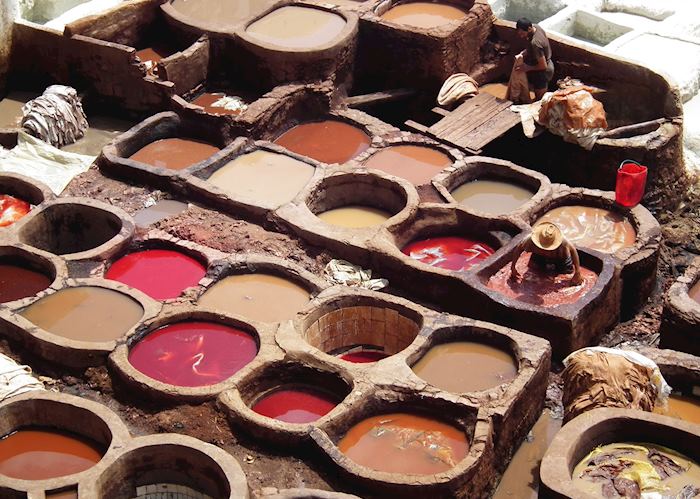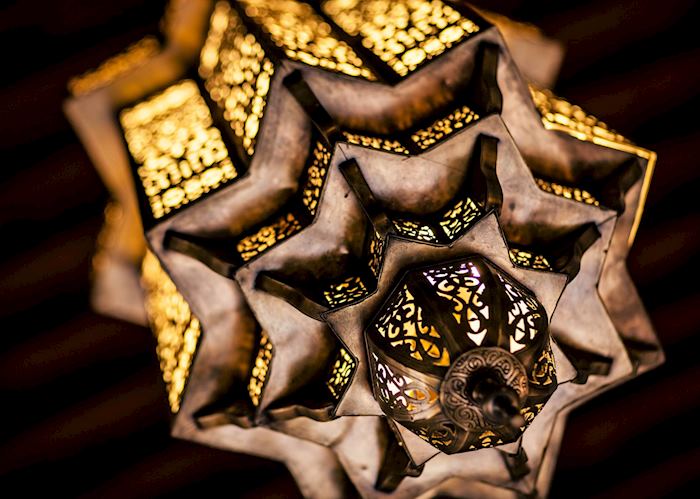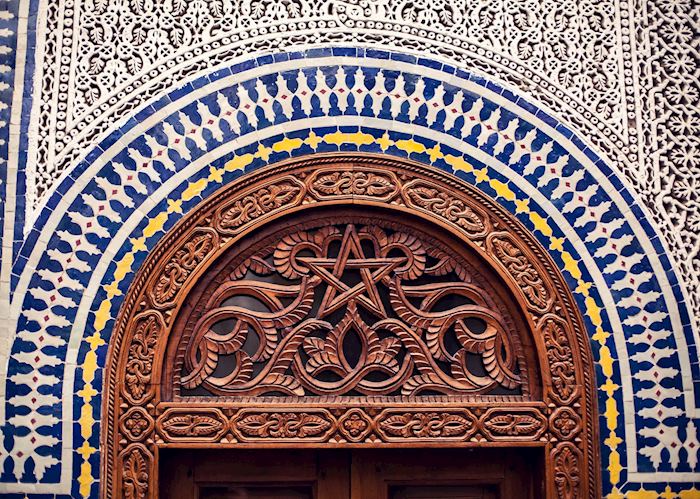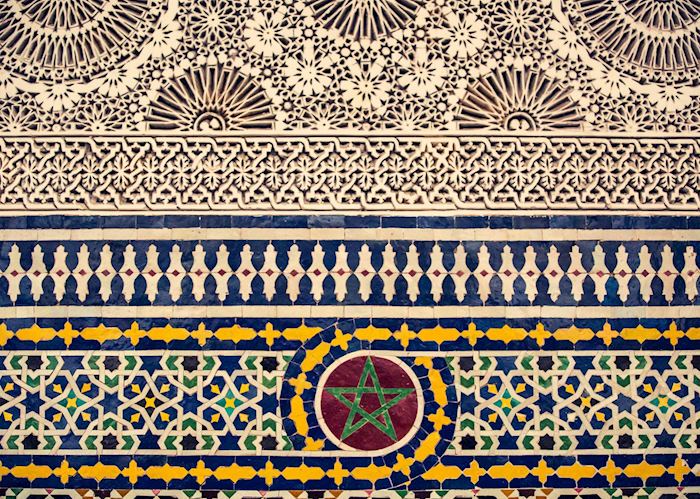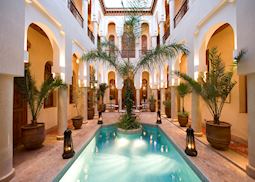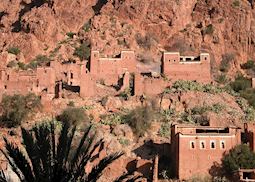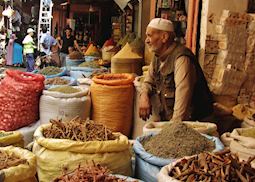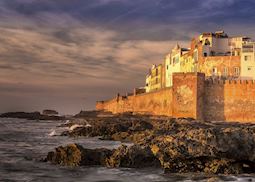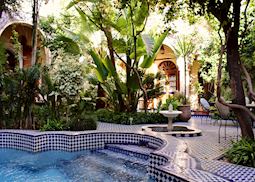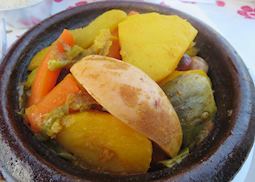Jump to:
Periodically capital of Morocco, the city of Fez has always occupied a place at the spiritual and political heart of the country. Founded in the ninth century, many of the early settlers were Islamic refugees, fleeing neighbouring Spain and Tunisia.
Those from Tunisia founded the Kairaouine Mosque at the heart of their quarter, which became one of the leading universities in the Islamic world, its theories were far in advance of those understood at the time in Europe.
Local architecture
 Many of the medressahs, built to house its students, still stand today and display exquisite craftsmanship. The medina and souqs are probably the best in Morocco, truly labyrinthine, assaulting the senses with new sounds, exotic scents and an intense experience unlikely to be rivalled elsewhere.
Many of the medressahs, built to house its students, still stand today and display exquisite craftsmanship. The medina and souqs are probably the best in Morocco, truly labyrinthine, assaulting the senses with new sounds, exotic scents and an intense experience unlikely to be rivalled elsewhere.
Many compare Fez to Marrakesh before the tourists arrived: it is certainly the most Arab of Moroccan cities, and in that sense has greater appeal to the purist.
who's been there
-
01993 838 92501993 838 420
- Make an enquiry
Suggested itineraries featuring Fez
Our itineraries will give you suggestions for what is possible when you travel in Fez, and they showcase routes we know work particularly well. Treat them as inspiration, because your trip will be created uniquely by one of our specialists.
Places near Fez
- Meknes & Volubilis 36 miles away
- Chefchaouen 79 miles away
- Rabat 107 miles away
- Asilah 115 miles away
- Tangier 128 miles away
- Casablanca 156 miles away
- The Dades Valley 195 miles away
- The Erg Chebbi 210 miles away
- Skoura 227 miles away
- Oued Mellah 238 miles away
- The Southern Oases Valleys 241 miles away
- Marrakesh 243 miles away
- Ouarzazate 245 miles away
- Ourika Valley 252 miles away
- Zagora 263 miles away
- The Atlas Mountains 266 miles away
Photos of Fez
Our expert guides to exploring Fez
Written by our specialists from their own experiences of visiting Fez, these guides will help you make the most of your time there. We share both our practical recommendations and the best ways to appreciate Fez at its best.
-
Riads and kasbahs of Morocco ![Riad Lydines, Marrakesh]()
Riads and kasbahs of Morocco
Riads and kasbahs of Morocco
A stay in a riad or kasbah offers intimacy, style, character and charm, and is undoubtedly a highlight of any trip to Morocco. Here at Audley we can recommend traditional accommodation to suit your preferences.
Read this guide -
Family holidays in Morocco ![Berber village in Ameln Valley, The Anti Atlas, Morocco]()
Family holidays in Morocco
Family holidays in Morocco
A vibrant and diverse country, Morocco is a very family-friendly destination with plenty of hands-on experiences and quirky accommodation options for families. Morocco specialist Kerry explains how to get the most out of your time here.
Read this guide -
Morocco food experiences ![Moroccan cuisine]()
Morocco food experiences
Morocco food experiences
Influenced over the centuries by numerous cultures, Moroccan cuisine is renowned for its delicious taste. We recommend dishes you should try and places to eat to help you make the most of your Moroccan food experience.
Read this guide -
Honeymoons in Morocco ![The Erg Chebbi, Morocco]()
Honeymoons in Morocco
Honeymoons in Morocco
Plan your perfect honeymoon to Morocco. Country specialist, Kerry, picks some of the country’s highlights, from exploring Marrakesh, Fez and the High Atlas Mountains to getting off the beaten track in the Sahara Desert and the town of Skoura with its collection of kasbahs.
Read this guide -
Your guide to the souqs of Morocco ![Marrakesh souq]()
Your guide to the souqs of Morocco
Your guide to the souqs of Morocco
The souqs of Morocco overflow with wares, including pierced lanterns, hand tied rugs and brightly dyed leather goods. Discover what you can expect and how to haggle for a rug with our insider’s guide to these vibrant markets.
Read this guide -
What to do in Morocco: our highlights guide ![Essaouira, Morocco]()
What to do in Morocco: our highlights guide
What to do in Morocco: our highlights guide
Morocco is a destination with fascinating local customs, a rich history and many geological wonders. Immerse yourself in the labyrinth of Medieval souqs, try the local cuisine, go walking in the beautiful High Atlas Mountains, or take a camel trip into the desert and sleep under the stars.
Read this guide
Accommodation choices for Fez
We've selected a range of accommodation options for when you visit Fez. Our choices usually come recommended for their character, facilities and service or location. Our specialists always aim to suggest properties that match your preferences.
-
![Riad Maison Bleue]()
-
![Riad Fes, Fez]()
Riad Fès
Fez -
![Ryad Salama, Fez]()
Ryad Salama
Fez
Ideas for experiencing Fez
Our specialists seek out authentic ways to get to know the places that could feature in your trip. These activities reflect some of the experiences they've most enjoyed while visiting Fez, and which use the best local guides.
-
Cookery lesson with a local family ![Vegetable tagine]()
Cookery lesson with a local family
Cookery lesson with a local family
Create your own tasty tagine dish and bake Moroccan bread at a traditional family home in Fez. Then sit down with the family to enjoy your culinary creation.
View details -
Fez city tour ![Local men working at the Tannery in Fez]()
Fez city tour
Fez city tour
A guided tour of Fez is an absolute must. More so than any city, there is a real danger of getting lost in the medina if not orientated, and also of missing some of the key sights of the city.
View details -
Fez tasting trail ![Sweets in the market of Fez]()
Fez tasting trail
Fez tasting trail
Take a culinary tour with your own personal guide who will help you to discover and taste the various delicacies of Fez.
View details






